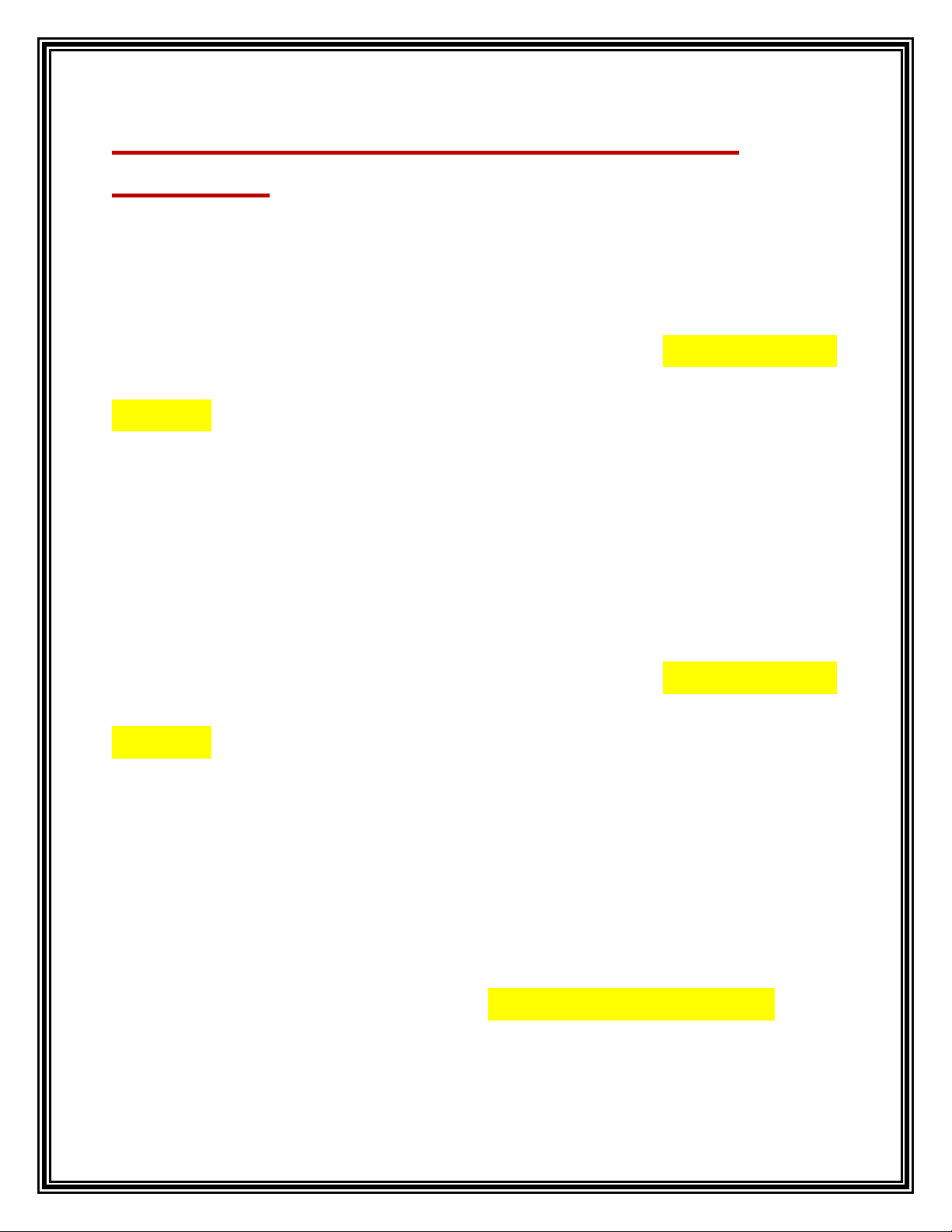
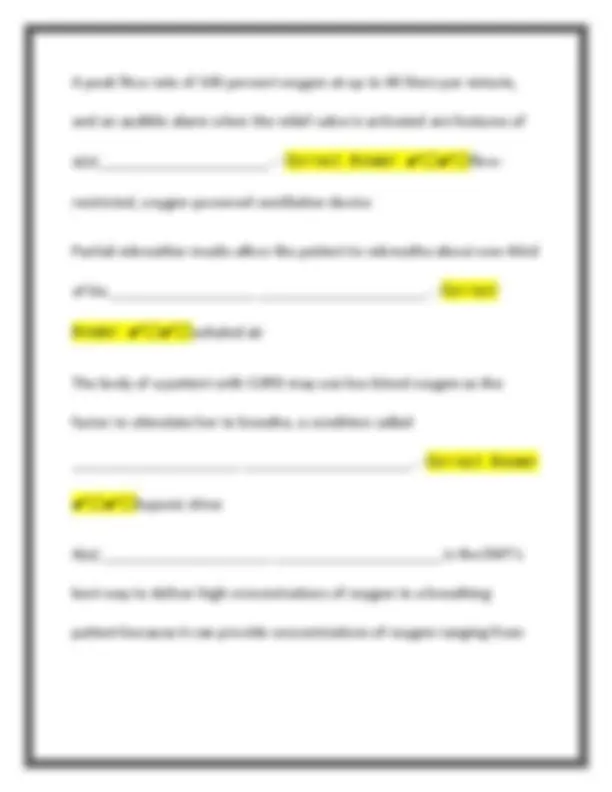
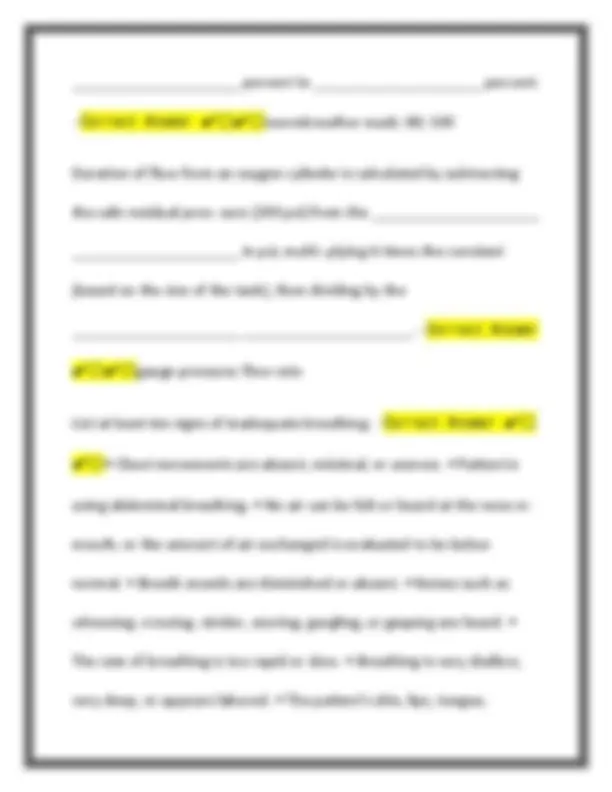
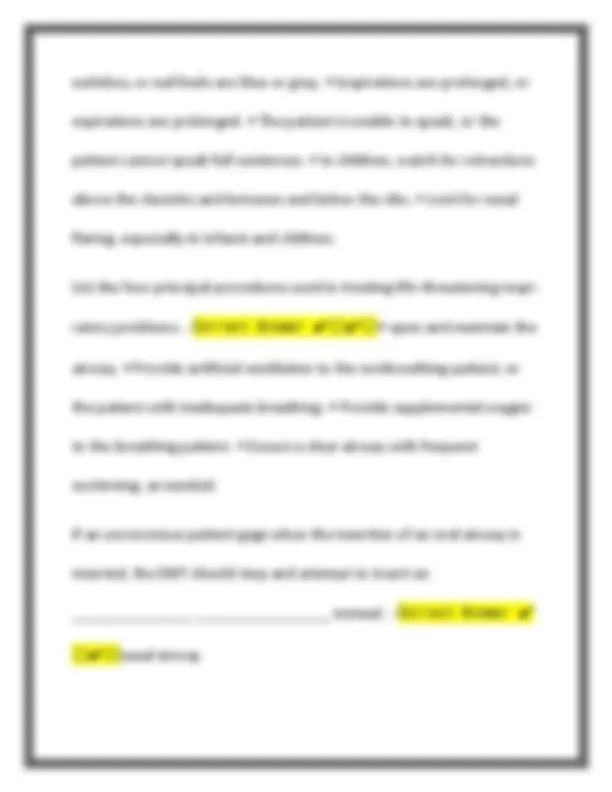
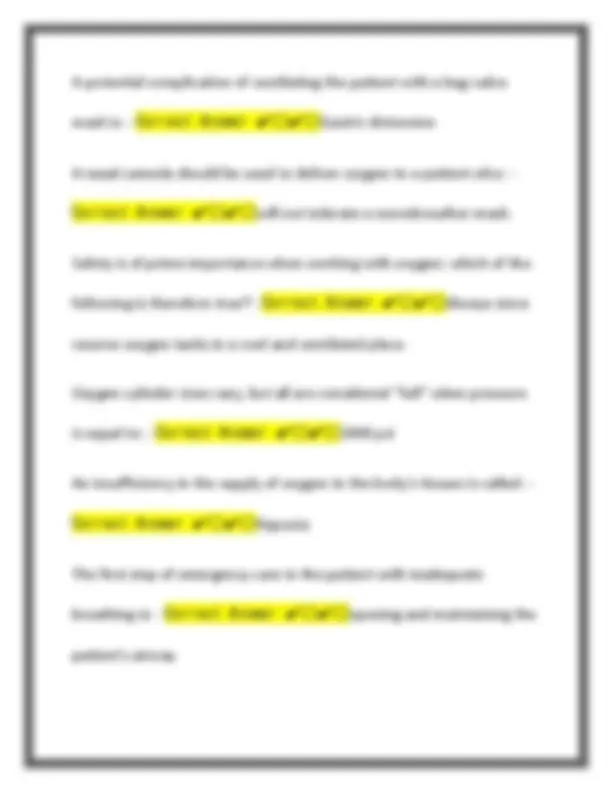
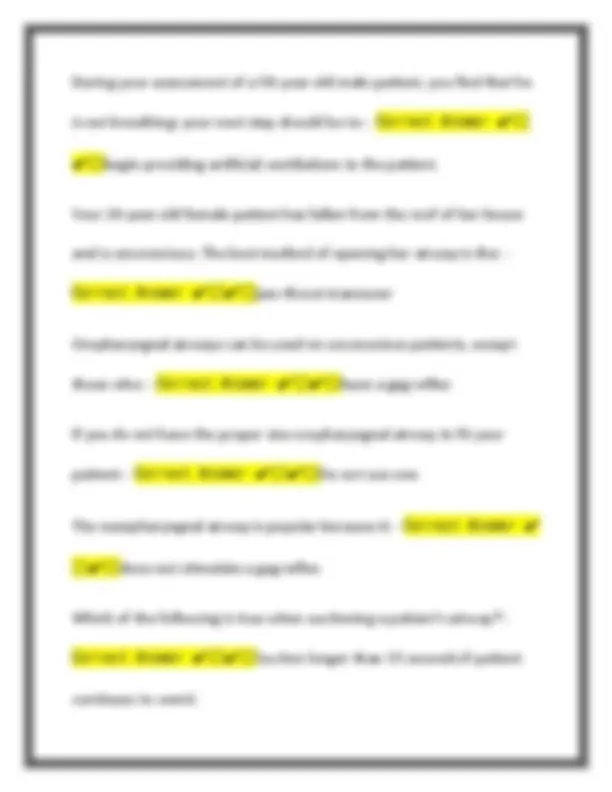
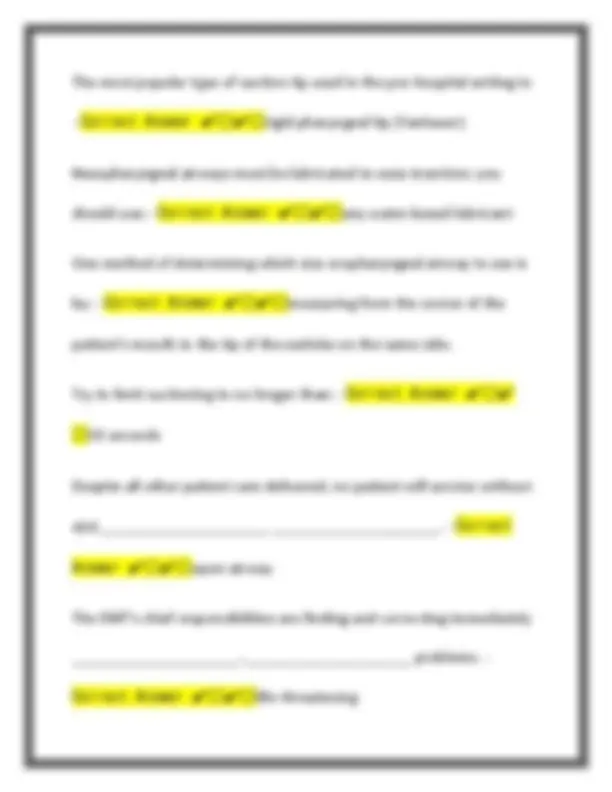


Study with the several resources on Docsity

Earn points by helping other students or get them with a premium plan


Prepare for your exams
Study with the several resources on Docsity

Earn points to download
Earn points by helping other students or get them with a premium plan
Community
Ask the community for help and clear up your study doubts
Discover the best universities in your country according to Docsity users
Free resources
Download our free guides on studying techniques, anxiety management strategies, and thesis advice from Docsity tutors
Emergency Care Chapter 9 and 10 Test Questions With High Expert Verified Answers
Typology: Exams
1 / 12

This page cannot be seen from the preview
Don't miss anything!







A person exhibiting signs of inadequate breathing is at risk of going into _____________________ _____________________. - Correct Answer
✔️ ✔️ respiratory failure
_____________________ _____________________ is the reduction of breathing to the point where oxygen intake is not sufficient to support life; when breathing stops completely, the patient is in _____________________ _____________________. - Correct Answer ✔️ ✔️ Respiratory failure; respiratory arrest
To determine the signs of adequate breathing, you should _____________________ for chest expansion, _____________________ for air, and _____________________ for air moving out of the nose and mouth. - Correct Answer ✔️ ✔️ look; listen; feel
A blue or gray color to the patient's skin or nail beds is called _____________________ and is a sign of breathing difficulty. - Correct
Answer ✔️ ✔️ cyanosis
The most difficult part of delivering BVM artificial ventilations is obtaining an adequate _____________________ _____________________. - Correct Answer ✔️ ✔️ mask seal
_____________________-_____________________ _____________________ are found on older BVMs and may prevent adequate ventilations. - Correct Answer ✔️ ✔️ Pop-off valves
BVM systems with an _____________________ reservoir can deliver approximately _____________________oxygen. - Correct Answer ✔️
✔️ oxygen; 100%
Venturi masks allow specific concentrations of oxygen by mixing oxygen with ________________ _____________________. - Correct Answer
✔️ ✔️ inhaled air
_____________________ percent to _____________________ percent.
Duration of flow from an oxygen cylinder is calculated by subtracting the safe residual pres- sure (200 psi) from the _____________________ _____________________ in psi, multi- plying it times the constant (based on the size of the tank), then dividing by the _____________________ _____________________. - Correct Answer ✔️ ✔️ gauge pressure; flow rate
List at least ten signs of inadequate breathing. - Correct Answer ✔️ ✔️ • Chest movements are absent, minimal, or uneven. • Patient is using abdominal breathing. • No air can be felt or heard at the nose or mouth, or the amount of air exchanged is evaluated to be below normal. • Breath sounds are diminished or absent. • Noises such as wheezing, crowing, stridor, snoring, gurgling, or gasping are heard. • The rate of breathing is too rapid or slow. • Breathing is very shallow, very deep, or appears labored. • The patient's skin, lips, tongue,
earlobes, or nail beds are blue or gray. • Inspirations are prolonged, or expirations are prolonged. • The patient is unable to speak, or the patient cannot speak full sentences. • In children, watch for retractions above the clavicles and between and below the ribs. • Look for nasal flaring, especially in infants and children.
List the four principal procedures used in treating life-threatening respi- ratory problems. - Correct Answer ✔️ ✔️ • open and maintain the airway. • Provide artificial ventilation to the nonbreathing patient, or the patient with inadequate breathing. • Provide supplemental oxygen to the breathing patient. • Ensure a clear airway with frequent suctioning, as needed.
If an unconscious patient gags when the insertion of an oral airway is inserted, the EMT should stop and attempt to insert an _______________ _________________ instead. - Correct Answer ✔️
✔️ nasal airway
The reduction of breathing to the point where oxygen intake is inade- quate to support life is called: - Correct Answer ✔️ ✔️ Respiratory failure
A 45-year-old is suffering from an acute asthma attack. You expect the patient to have: - Correct Answer ✔️ ✔️ Decreased tidal volume
Which of the following methods for providing ventilatory assistance is considered most effective? - Correct Answer ✔️ ✔️ Two-person bag-valve mask technique with high-flow supplemental oxygen
Signs of inadequate artificial ventilation of an adult patient include: - Correct Answer ✔️ ✔️ failure of the patient's skin color to improve.
If oxygen is connected to a pocket face mask, the setting on the oxygen tank regulator should be set to: - Correct Answer ✔️ ✔️ 15 lpm
What device on a bag-valve mask may prevent adequate ventilation? - Correct Answer ✔️ ✔️ A pop off valve
A potential complication of ventilating the patient with a bag-valve mask is: - Correct Answer ✔️ ✔️ Gastric distension
A nasal cannula should be used to deliver oxygen to a patient who: - Correct Answer ✔️ ✔️ will not tolerate a nonrebreather mask.
Safety is of prime importance when working with oxygen; which of the following is therefore true? - Correct Answer ✔️ ✔️ Always store reserve oxygen tanks in a cool and ventilated place.
Oxygen cylinder sizes vary, but all are considered "full" when pressure is equal to: - Correct Answer ✔️ ✔️ 2000 psi
An insufficiency in the supply of oxygen to the body's tissues is called: - Correct Answer ✔️ ✔️ Hypoxia
The first step of emergency care in the patient with inadequate breathing is: - Correct Answer ✔️ ✔️ opening and maintaining the patient's airway
The most popular type of suction tip used in the pre-hospital setting is:
Nasopharyngeal airways must be lubricated to ease insertion; you should use: - Correct Answer ✔️ ✔️ any water-based lubricant
One method of determining which size oropharyngeal airway to use is by: - Correct Answer ✔️ ✔️ measuring from the corner of the patient's mouth to the tip of the earlobe on the same side.
Try to limit suctioning to no longer than: - Correct Answer ✔️ ✔️ 10 seconds
Despite all other patient care delivered, no patient will survive without a(n) _____________________ _____________________. - Correct Answer ✔️ ✔️ open airway
The EMT's chief responsibilities are finding and correcting immediately _____________________-_____________________ problems. - Correct Answer ✔️ ✔️ life-threatening
Minimal or uneven chest movements, diminished breath sounds, and noisy breathing are signs of _____________________ _____________________. - Correct Answer ✔️ ✔️ inadequate breathing
The two procedures commonly used for opening a patient's airway are the _____________________-_____________________, _____________________- _____________________ maneuver if no trauma is suspected, and the _____________________- _____________________ maneuver, if head, neck, or spine in- jury is suspected. - Correct Answer ✔️ ✔️ head-tilt, chin-lift; jaw-thrust
The most common impediment to an open airway is the _____________________. - Correct Answer ✔️ ✔️ tongue
Use an airway adjunct on all _____________________ patients who do not exhibit a _____________________ _____________________. - Correct Answer ✔️ ✔️ unconscious; gag reflex